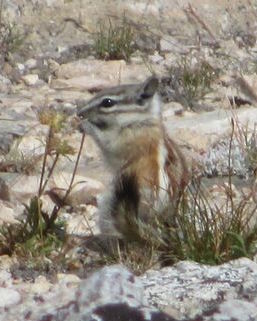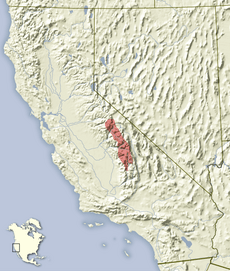Alpine chipmunk facts for kids
Quick facts for kids Alpine chipmunk |
|
|---|---|
 |
|
| Conservation status | |
| Scientific classification | |
| Genus: |
Neotamias
|
| Species: |
alpinus
|
| Synonyms | |
|
Tamias alpinus Merriam, 1893 |
|
The alpine chipmunk (Neotamias alpinus) is a small, quick animal. It is a type of chipmunk. These chipmunks live high up in the Sierra Nevada mountains of California.
Contents
About the Alpine Chipmunk
Alpine chipmunks are usually gray-brown. They have special markings that help identify them. You'll see three white stripes on their cheeks. They also have four white stripes running down their back. The sides of their body are a soft orange color. Their fur is lighter than many other chipmunk types. These small animals weigh between 27 and 45 grams. That's about the same as a few strawberries!
Where Alpine Chipmunks Live
Alpine chipmunks are found only in the high parts of the Sierra Nevada mountains. Their home stretches from Yosemite National Park in the north. It goes all the way south to Olancha Peak. These chipmunks live at very high elevations. They are seen from about 2,300 meters (7,500 feet) up to 3,900 meters (12,800 feet). However, they usually stay above 2,500 meters (8,200 feet).
How Alpine Chipmunks Live
Alpine chipmunks eat seeds from different plants. They like seeds from sedges, grasses, and other plants that grow in their mountain home. They usually eat their food right on the ground. These chipmunks do not need much water to drink. They get most of the water they need from their food. But they will drink water if it is available.
Nests and Young
Alpine chipmunks make their nests in cracks between rocks. These rock cracks offer warmer spots. This helps them stay cozy. Baby chipmunks are born in June and July. A mother chipmunk usually has 3 to 6 babies at a time.
Daily Life and Winter Sleep
Alpine chipmunks are mostly active during the day. This means they are diurnal animals. But sometimes they are active at night during the summer. They hibernate during the colder months. This long sleep lasts from November through April. During hibernation, they often wake up to eat some of their stored food.
See also
 In Spanish: Tamia alpina para niños
In Spanish: Tamia alpina para niños



